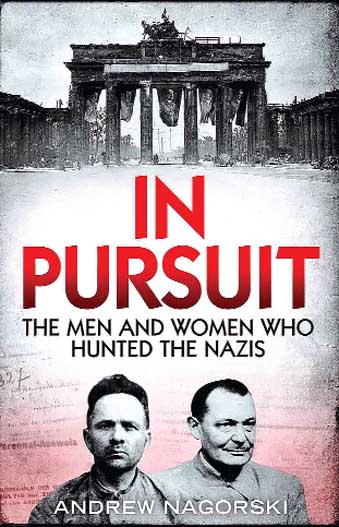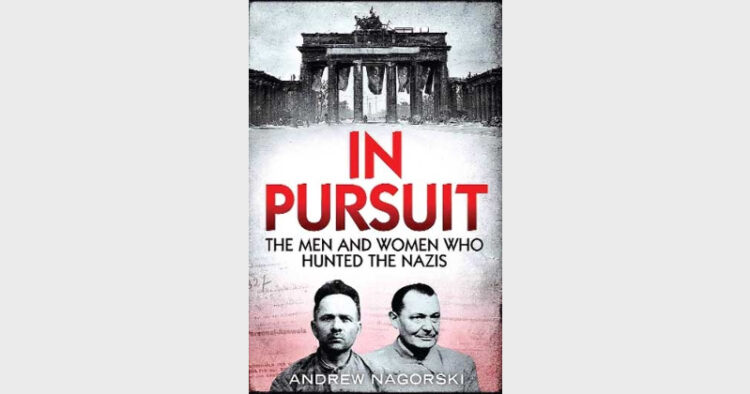| In Pursuit: The Men and Women Who Hunted the Nazis; Andrew Nagorski; Simon & Schuster Ltd; Pp 416; Rs 699 |
Andrew Nagorski tells the saga of Nazi hunters who refused to allow the crimes committed by Nazis to be forgotten, an unforgettable tale of gritty determination and relentless pursuit
P Sandeep
 As its title, the book In Pursuit reveals the stories of great pursuance by men and women to bring Nazi war criminals to justice. People from different countries at different times chased Nazis for their role in the holocaust. Some of such Nazi hunters had no direct connection with time and events occurred in Germany or other countries under Hitler’s orders. But, still with great resilience they worked to bring Nazi henchmen to trail. What motivated them? The book provides us with narratives of such Nazi hunters and their saga. Though many of the names are not so familiar to the world, stories of the commendable deeds of such unknown people make the book worth reading.
As its title, the book In Pursuit reveals the stories of great pursuance by men and women to bring Nazi war criminals to justice. People from different countries at different times chased Nazis for their role in the holocaust. Some of such Nazi hunters had no direct connection with time and events occurred in Germany or other countries under Hitler’s orders. But, still with great resilience they worked to bring Nazi henchmen to trail. What motivated them? The book provides us with narratives of such Nazi hunters and their saga. Though many of the names are not so familiar to the world, stories of the commendable deeds of such unknown people make the book worth reading.
The beginning of the book may give you a feel of old Sanskrit plays, in them the names of the characters would appear in the first. Here also the names of prominent persons are listed in the initial pages, and of course, it would increase your familiarity with the characters while reading progress.
It really starts with the stories of Nuremberg trials in which top Nazi leaders were tried. The hanging of top Nazi leaders after the trials, the last words of those top Nazis who went to gallows, the picturesque images of the actions of their hangman Woods depicted in the book, etc. may leave a long lasting impression on you.
Not only that the book would take you to the horrible images of the holocaust, the largest and one of the most organised racial genocides in the history of mankind. If you reflect on the magnitude of human lives perished in the gas chambers and brutal precision with which Nazis executed it, no doubt, it will bring nightmares to you. The sheer number of human lives perished in holocaust camps itself is beyond imagination. The images of mothers telling stories to their kids to deflect their attention while going into gas chambers and the final march of thousands of innocent children into the gas chambers narrated in the book are really heart breaking. There are even more horrible narrations of human evil in this book. The author says that a witness said to him that an officer pulled a small boy and smashed to a wall the kid instantly died. After that the officer started eating an apple, as such there is nothing happened. Horror is that the boy was carrying the same apple just before his death. At Nazi death camps, prisoners endured a great amount of torture, starvation and mental agony before going into the gas chambers. Many people died before reaching the gas chambers due to the same reasons. The stories of medical experiments on prisoners and even the medical practitioners killing of prisoners by injecting different hazardous substances etc. are awful.
Mapping Human Rights and Subalterns in Modern India; Jagannatham Begari; Kalpaz Publications; Pp 305; Rs 990 The book attempts to trace the dynamics of Human Rights discourse and the rights of subalterns in modern India. It critically evaluates the notion of exclusion of subalterns in modern India from the mainstream social system and the present development model Imprints of the Past: An archaeological outline of northeast India; BS Harishankar; Vivekananda Kendra Institute of Culture; Pp 289; Rs 250 The book brings to focus the beginnings of agriculture and domestication, trade and technology as well as the great Buddhist monastic complexes of eastern India and their role in the cultural synthesis of the Ganga-Brahmaputra valleys The Thar Articles; BB Dandekar; Gyan Publishing House; Pp 248; Rs 980 The novel is brilliant in its study of the interreligious, cross-cultural marriage of an Indian-Jewish Colonel in the Indian Army and a I want to be Tendulkar!; Manish Sharma; genNext Publication; Pp 234; Rs 199 The writer is a journalist with almost 13 year of experience. With his eminent and |
The events occurred in Germany and elsewhere in the sidelines of the World War II, under the aegis of an autocratic regime remind us how deadly absolute power is. Such autocratic regimes become even more lethal when it is laced with a regressive ideology and ruthless bureaucratic organisation. An absence of sensitivity and lack of consciousness among the Nazi officials while executing the most inhuman orders certainly arouse doubt in our mind about the evil side of human beings and their organisations. We may compel to think that all bureaucratic organisations across the globe are inhuman in its essence when it becomes insensitive. Perhaps such beastly traits are not only of Nazis as widely propagated and believed. This book itself provides an instance of a barbaric act of communist in the name of retribution. Which can be read as follows in the words of a communist, “As late as November 6 and 7,
1945, the anniversary of the Bolshevik Revolution, Hermann Matazkowiski, a German communist who was appointed as the mayor of a district of Konigsberg by the new Soviet authorities, noted that the occupiers appeared to have been given official sanction for additional retribution. Men were beaten, most women were raped, including my seventy-one-year-old mother, who died by Christmas” he wrote.
Perhaps realising the horror of revenge, the book says the Nazi hunters and the governments who brought perpetrators of the holocaust to trail set a tone that their aim is not revenge but justice to the victims. The book says the main objective of the governments and Nazi hunters were documentation of the horrible events and the persons responsible for that. They intend to create historical records so as to educate the young generation and ensure that such dreadful happenings will not occur in future. Of course, many of those culprits of the worst genocide in the history were brought to justice and punished. More than the governments, the individuals who worked relentlessly with absolute resolute deserve applaud. They did their role in repairing the human errors in the shared history of mankind. Nazi hunters also teach us how to look into an issue from different angles and how useful it is in a historical perspective. I am sure Simon Wiesenthal, Beate Klarsfed, and Jan Shen, the names of prominent Nazi hunters, will remain with you for a long time. The author of the book, Andrew Nagorski deserves special commendation for this beautifully researched piece. He also deserves appreciation for
presenting a historical subject in an attractive and very readable format. No doubt, the book will contribute immensely to think and reflect, about human beings, their organisations and their history.













Comments